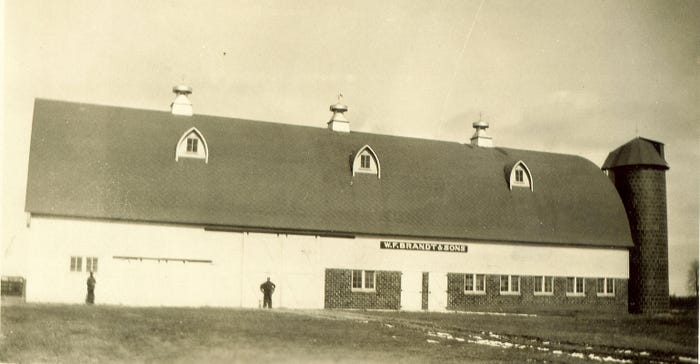May 25, 2017

The Brandt farm is located in Bay City in Portsmouth Township. It was originally purchased Aug. 21, 1869, by Henry W. Brandt, Rebecca Brandt’s great-great-great-grandfather, and has been in continuous ownership by the family for nearly 150 years.
The barn was built in 1929 by Brandt’s great-grandfather William Brandt (Henry’s grandson) and his sons, Hank and Bill. “We are fortunate to have a nice record of the barn’s construction, because early photos have been carefully preserved,” says Brandt.
The most noticeable feature of the barn, aside from its large size, is the round or rainbow roof as opposed to the more typical gambrel roof that many people associate with barns.

MEMORIES: Old photos helped preserve the history of the barn. The most noticeable feature of the barn, aside from its large size, is the round or rainbow roof, as opposed to the more typical gambrel roof that many people associate with barns. (Photos courtesy of Rebecca Brandt)

It is likely that the east half of the barn was either of kit-barn construction or was built in the style of barns popular at the time. One picture shows an old wooden barn sitting in front of the new barn as it was being constructed. “It is our assumption that the older barn was either moved or dismantled and then reconstructed onto the west end of the new barn, nearly doubling it to its current size of 40 feet by130 feet,” Brandt says.
Reused from the previous barn, the old hand-hewn timbers with bark intact are visible in the west half of the barn’s interior. This area once served as a tool room and storage for seed potatoes and grain, she says. The grain was brought from the field, shoveled into the grain bins, and later taken to the elevator in Munger to be ground for feed on the farm or sold.

The loft originally stretched the entire length of the barn with a hay mow on the west end and a straw mow on the east. The main floor included 35 cow stanchions, a bull pen, a large calf pen and a four-stall horse area. “As my grandfather transitioned into mechanized equipment in the 1940s and ’50s, Duke and Dolly, the workhorses used by my great-grandfather, were retired and eventually buried under a large oak tree in back of the farm,” she adds.
Milk from the farm was strained, put into cans and stored in the small milkhouse behind the barn. “My grandparents would pack the cans in the car and drive them to the dairy in Bay City, returning with empty cans to repeat the process every few days until the dairy operation ceased in the1960s,” Brandt says.
As with most farms, there were a lot of hazards that came with the barn. “My aunt recalls being warned not to play by the silo, reminders to keep hands away from horses and machinery, bone-breaking falls from the hay mow, and a tough lesson on the power of a cow’s kick after grandpa had his nose end up on his cheek, while hooking up a milking machine … and the even tougher story of how doctors back then set noses back into place,” she says.
“The good times have always outweighed the bad, and we are fortunate to have had generations of family and friends to share it with. Kids especially have always loved to come to the farm and explore the barn with all of the open space to play.”
Much of the barn was updated in the 1970s and ’80s to accommodate larger farm equipment, which included removing the stanchions and part of the loft, improving concrete, and adding steel siding. The barn currently is used for storage, and an extensive project to replace the roof was undertaken in 2015. The old milkhouse and chicken coop still stand on the property.
“My sister Jennifer and I currently live in separate houses on the farm, and are the sixth generation of the Brandt family to live here,” Brandt says. “Together with our three other sisters, we own 160 acres surrounding the barn used to raise corn, soybeans and wheat.”
The barn is also featured on the cover of the book “Michigan Barns, Et Cetera: Rural Buildings of the Great Lake State” by Jerry R. Davis. The book features skillfully drawn illustrations of rural buildings throughout Michigan.
“Our farm will proudly be celebrating 150 years in our family in 2019, and we look forward to preserving it for future generations,” Brandt adds.
Arnett writes from Battle Creek.
About the Author(s)
You May Also Like




